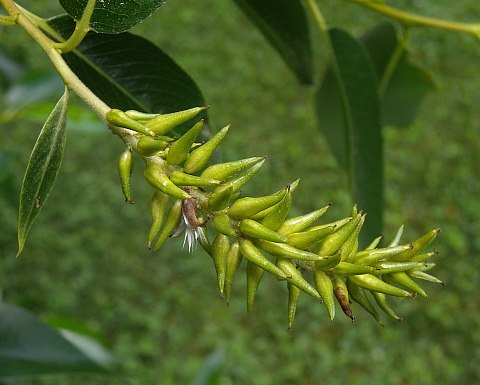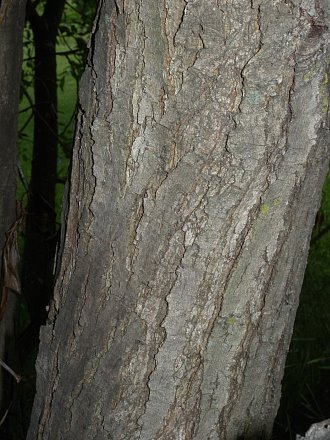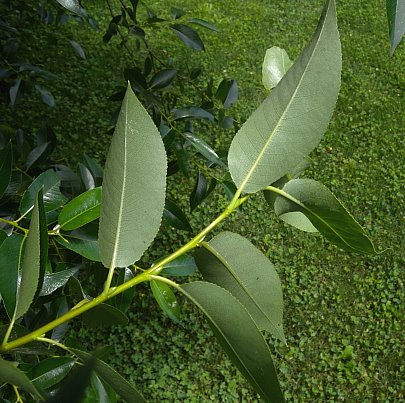
Bay-Leaved Willow is dioecious, developing staminate (male) and pistillate (female) catkins on separate trees. The central stalks of both staminate and pistillate catkins are short-pubescent. The staminate catkins are about 1-2½" long, cylindrical in shape, yellowish, and more or less ascending. Individual staminate florets consist of 4-10 stamens (usually about 5); they have neither petals nor sepals. There is a single hairy bract at the base of each staminate floret and a pair of tiny glands. The pistillate catkins are 1½-3" long, cylindrical in shape, greenish, and spreading to ascending. Individual pistillate florets consist of single naked ovaries that are lanceoloid, hairless, shiny, and up to 6 mm. (¼") long; they have neither petals nor sepals. There is a single hairy bract at the base of each pistillate floret and a pair of tiny glands. The pedicel of each pistillate floret is very short (about 1 mm. in length). The blooming period occurs during late spring for about 1-2 weeks. By the middle of summer, the pistillate florets develop into seed capsules about 6-8 mm. in length. These capsules turn brown and split open to release their seeds. The tiny seeds are enclosed in fine cottony hairs to assist their dispersal in the wind. The woody root system consists of shallow lateral roots. It does not produce clonal offsets from underground runners.

Cultivation: The preference is full sun, moist conditions, somewhat acidic fertile soil, and a boreal climate, although this willow tolerates a variety of situations. The tiny seeds remain viable for only a short period of time and should be planted in moist soil within 1-2 weeks. Vegetative propagation is possible by cutting small branches during the spring and inserting them into moist ground. Most growth and development occurs from late spring to mid-summer. In Illinois, this willow drops its leaves by early fall.
Range & Habitat: The introduced Bay-Leaved Willow rarely naturalizes in Illinois. So far, it has escaped from cultivation in only 3 counties (see Distribution Map). This small tree or shrub is native to Eurasia and it was introduced into the United States as an ornamental landscape plant. It does not appear to be invasive in Illinois. Habitats include borders of creeks and other wetlands, roadsides, and waste areas. Bay-Leaved Willow is occasionally cultivated in city parks and lawns.

Faunal Associations: Apparently, specimens of Bay-Leaved Willow in North America consist entirely of those with pistillate catkins. As a result, only nectar is available as a floral reward. Typical floral visitors of willows (Salix spp.) include cuckoo bees (Nomada spp.), mason bees (Osmia spp.), Halictid bees (Halictus spp., Lasioglossum spp., etc.), Andrenid bees (Andrena spp.), Syrphid flies, Muscid flies, thick-headed flies (Conopidae), other miscellaneous flies, miscellaneous beetles, Ichneumonid wasps, and sawflies. Other insects feed on the leaves, bore through the wood, or suck plant juices from willows. These species include caterpillars of the butterflies Limenitis archippus (Viceroy), Limenitis arthemis arthemis (White Admiral), Limenitis arthemis astyanax (Red-Spotted Purple), Nymphalis antiopa (Mourning Cloak), Nymphalis vau-album j-album (Compton Tortoiseshell), Satyrium acadicum (Acadian Hairstreak), and Satyrium liparops strigosum (Striped Hairstreak); caterpillars of the skipper Erynnis icelus (Dreamy Duskywing) also feed on willows. The caterpillars of an even greater number of moths feed on these woody plants; they include such species as Cabera variolaria (Pink-Striped Willow Spanworm), Catocala relicta (White Underwing), Colobochyla interpuncta (Swamp Belle), Micrurapteryx salicifoliella (Willow Leaf-Miner), and Notodonta scitipennis (Fanned Willow Prominent). Other insect feeders include the wood-boring larvae of long-horned beetles (Saperda spp., etc.), leaf beetles (Chrysomela spp., Disonycha spp., etc.), Aphis salicariae (Willow Aphid) and Tuberolachnus salignus (Giant Willow Aphid), leafhoppers (Davisonia spp., Idiocerus spp., Kybos spp., etc.), Lopidea salicis (Willow Plant Bug) and other plant bugs, larvae of Nematis ventralis (Willow Sawfly) and other sawflies, the larvae of Rhabdophaga strobiloides and other gall flies, and Microcentrum retinervis (Angular-Winged Katydid). Some vertebrate animals also feed on various parts of willows. Willow catkins or buds are eaten by such birds as the Northern Pintail, Mallard, and Ruffed Grouse, and by such mammals as the Red Squirrel and Fox Squirrel. White-Tailed Deer browse on the twigs and foliage, while beavers use the bark and wood as a source of food and construction materials for their dams and lodges. Willows also provide nesting habitat for various birds, including the Rusty Grackle, Yellow Warbler, and Warbling Vireo.

Photographic Location: The Arboretum at the University of Illinois in Urbana, Illinois.
Comments: The stiff shiny leaves of this willow are very ornamental. On this basis alone, it is relatively easy to distinguish Bay-Leaved Willow from most other willows. However, another willow species, the native Salix lucida (Shining Willow), also has shiny leaves and a similar appearance. The leaves of Shining Willow tend to have long-tapering tips, while those of Bay-Leaved Willow tend to have short-tapering tips. Shining Willow also has more persistent stipules at the bases of its petioles. Another willow with shiny hairless leaves, the native Salix serissima (Autumn Willow), differs from the preceding species by the whitened undersides of its leaves. Both Shining Willow and Autumn Willow are uncommon in Illinois; they are found primarily in the NE section of the state.